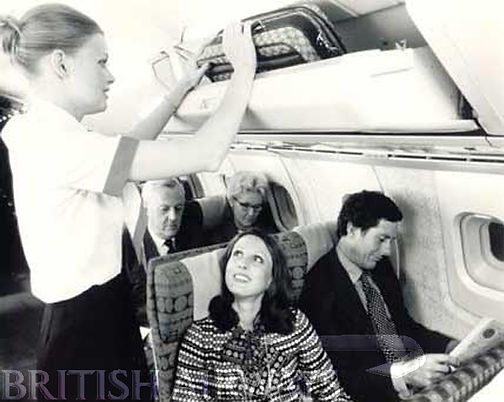Explore the world of Concorde with Heritage Concorde
Concorde Cabin Interiors
The completed scheme, was quieter than the traditional approach, it echoed the look of smaller executive jets, with leather applied to bulkhead surfaces and with just one colour of fabric for the seats. To offset the relative narrowness of the seats, the fabric was horizontally striped and armrests upholstered with leather to match the bulkheads. The first Concordes were delivered with a very traditional interior design that was intended to reassure the passengers using this supersonic aircraft. In fact, the passengers were disappointed to be offered an interior which did not reflect the futuristic external appearance of this unique aircraft. Consequently, British Airways commissioned a new design scheme, to be implemented without interruption to Concorde’s flying schedule.
The new scheme was designed for piece-by-piece introduction and as each new element was introduced, it had to fit in with any remaining parts of the old interior.

British Airways Concorde Passenger interiors from the 1970s







British Airways Concorde Passenger interiors 1993 – 2001



During May and June of 1993, Concorde G-BOAF completed her ‘D’ check, she was then returned to the BA Engineering building at Heathrow known as TBB. During which time she became the first Concorde to receive the new cabin interior upgrades, some of which would last up until Concorde left service in October 2003. The upgrades featured new leather seats, larger overhead bins, new leather covers bulkheads, new galleys, improved toilets, a new in-flight entertainment system and new passenger and cabin lighting.
The new seats which are known as the 2000/2050 Series Double Seat Units, were designed to offer the maximum comfort and seat width combined with a pleasant appearance built into a simple but robust construction. The seats were furnished in a smart effective colour scheme to enhance the completed installation throughout the aircraft.A folding table is stowed in the rear face of each backrest. These tables are mounted on legs which pivot within each backrest assembly. Magazine pockets are also provided on the rear face of the backrest, and are located below the folding table.


BA Concorde Passenger interiors 2001 – 2003 “Project Rocket”


BA approached Factory Design to do a redesign of their Concorde interiors. The key features of this planned upgrade known as “Project Rocket” had to do with the seat design. Drawing inspiration from Charles and Ray Eames’ chairs the new seats were covered in ink-blue Connolly leather and fabric with a cradle mechanism, footrest and contoured headrest to support the passengers head after all that champagne. The new design was 10% lighter, resulting in fuel savings that actually paid for the upgrade.
Although the seating was fitted to their fleet, the rest of the planned passenger cabin upgrades were not, this was due to the fact that Concorde was retired in 2003, before the upgrades could be completed. They also wanted to make the interior of the passenger cabin lighter and brighter by using different lighting filters to give a fresher look that would change to a cool blue wash throughout the cabin when Concorde flew through the sound barrier at Mach one.
The toilets, too, would have had a facelift, getting new opaque wall panels that would have been up-lit and down-lit to increase the sense of space. They would have been done in aqua green colours with stainless steel.




Air France Concorde Passenger interiors


Air France’s original interiors were designed by the late great Raymond Loewy:
When Andrée Putman redesigned them for Air France in the 1990s, some thought that she had overdone the look. Concordes are notoriously aircraft, with cramped seating and no visual entertainment system (after all, you’d be in New York before you left London!). The main entertainment for Concorde’s customers was getting sloshed on champers whilst picking away at fine foods served nearly 20 km up there in near-space.Andrée’s interiors conveyed a certain French elegance. They were right for the time, although by 2003 seemed very dated compared to the BA fleet.

